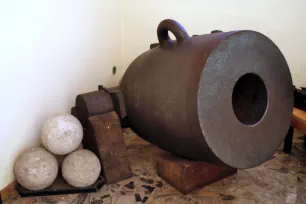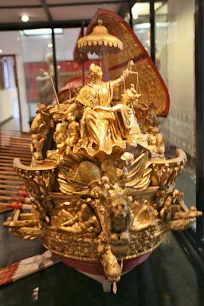Venice’s Naval History Museum showcases the city’s rich maritime history, which dates back hundreds of years.



Situated near the Arsenale in the eastern Castello district of Venice, Museo Storico Navale is considered to be one of the best museums of its kind. From the time you enter the main door, surrounded by two enormous anchors from Austrian ships seized during The Great War, you’ll be thrilled by the artifacts, photos, models, and other displays that grace the museum’s five stories, especially if you’re a navy buff.
History
The origins of Venice’s Naval Museum go back to 1815 when the Austrians, who occupied the city at the time, decided to archive historic ship models built in the Arsenale. Soon other naval artifacts were added to the collection, such as canons and a replica of the Doge’s ceremonial barge. Since 1958 the collection is housed in a historic fifteenth-century granary.
Today the museum covers not only the naval history but all of Italy as well, making it the country’s most important naval history museum.
At the Museum
The museum’s ground floor is dedicated to artillery used by the Venetian army, as well as Venetian fortresses. There is also a World War II exhibit that features a number of torpedoes, including a large, low-speed torpedo used in the Second World War. Divers steered the torpedo’s manually, jumping off just before impact. One such torpedo sunk the Queen Elisabeth during WWII.


One of the rooms on the ground floor is dedicated to the service of Angelo Erno, an eighteenth-century admiral who is best known in Italy for his battles against Algiers and for his attempts to reorganize the Arsenale and maintain Venice’s once-great naval power. Many consider him Italy’s last great naval hero.
Climb to the next floor, and you’ll find a sizeable exhibit on Admiral Francesco Morosini of the seventeenth century. He is best known to Italians as the man who drove the Turks out of the Peloponnese – a peninsula in Greece – in the late 1600s. Unfortunately, he also received a lot of negative publicity for bombarding the Parthenon in Athens in 1687, causing irreparable damage to the historic structure.
Another, even more renowned battle is also covered in the museum: the Battle of Lepanto in 1571, in which an alliance – known as the Holy Fleet – including the Venetians crushed the Turkish fleet.
Bucintoro
One of the most fascinating displays in the Museo Storico Navale is a collection of model ships – some up to two meters long – with amazingly intricate detail, spanning hundreds of years and including both military and merchant ships. One room is dedicated to the Bucintoro, a ceremonial barge used by the Doges of Venice. The barge was used on Ascension Day, when the Doge would throw a ring in the water as a symbol of the unity between Venice and the sea.
Gondolas

On the third floor, guests will find displays related to non-military sea-faring expeditions and activities, including an exhibit about the history of merchant vessels, a display of traditional fishing gear, and a fascinating exhibit about the history of gondoliers, including a display of several ornate gondolas. Amongst them is the gondola of Peggy Guggenheim, which was donated to the museum after her death in 1979. Another room displays models of oriental vessels, such as Chinese junks.
The fourth floor is dedicated to the connection between the Italian and the Swedish Navy, with models of Swedish ships on display. An adjacent room features a large and valuable collection of seashells, some of them enormous in size.

